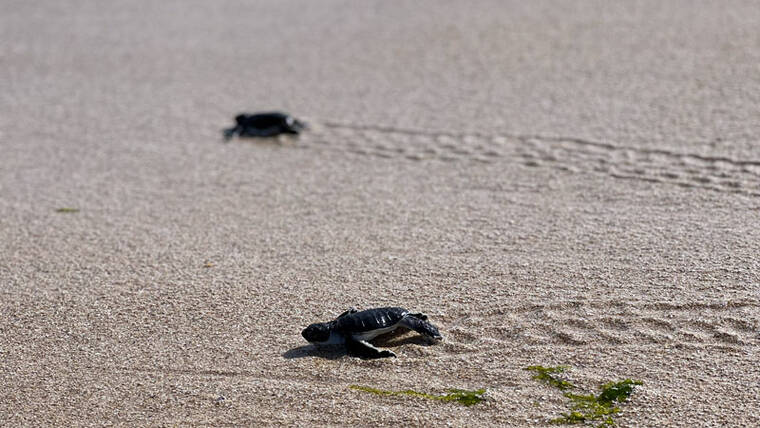Lights out at Sandy Beach Park to protect 6 honu nests


COURTESY SHELDON PLENTOVICH
Hatchings emerge from Sandy Beach Park.

COURTESY HONOLULU DEPARTMENT OF PARKS AND RECREATION
On Sept. 22, a honu nest was excavated at Sandy Beach Park 24 hours after the last hatchling emerged. The U.S. Fish and Wildlife Service is asking people to be mindful of nesting sea turtles. Six nests have been discovered at the beach park. The city has deactivated about a dozen lights at the park to avoid disorienting the turtle hatchlings.

COURTESY HONOLULU DEPARTMENT OF PARKS AND RECREATION
On Sept. 22, a honu nest was excavated at Sandy Beach Park 24 hours after the last hatchling emerged. The U.S. Fish and Wildlife Service is asking people to be mindful of nesting sea turtles. Six nests have been discovered at the beach park. The city has deactivated about a dozen lights at the park to avoid disorienting the turtle hatchlings.




Honolulu officials have temporarily turned off some lights at Sandy Beach Park to help ensure the safe passage of green sea turtle hatchlings toward the sea.
The Honolulu Department of Parks and Recreation announced over the weekend the deactivation of about a dozen free-standing and restroom lights near Halona Blowhole at the request of wildlife officials.
This reduces artificial light from disorienting honu hatchlings and seabird fledglings who rely on moonlight to guide them out to sea.
The U.S. Fish and Wildlife Service is also asking the public to be on the lookout for turtles on local beaches during nesting season, which began in mid-April but can last as late as December. Hatchlings generally emerge at night.
The first of six honu nests were discovered at Sandy Beach in mid-July, according to officials, with approximately 72 eggs believed to be buried in sites stretching from the blowhole side of the beach to Ocean Safety Lifeguard Tower 4B.
“As stewards of these public lands, it is important for us to find a balance between the environmental, recreational, and cultural needs of parks users and the wildlife which enjoy these shared spaces,” said DPR Director Laura Thielen in a news release. “We hope that turning off these lights is a big first step in giving these precious young wildlife a better chance at survival, as well as an opportunity for the public to become more informed about this nesting situation. Mahalo to our government, non-profit, and volunteer partners who have guided much of the protection and education efforts for wildlife conservation.”
Don't miss out on what's happening!
Stay in touch with breaking news, as it happens, conveniently in your email inbox. It's FREE!
Sheldon Plentovich, USFWS Pacific Islands Coastal Program coordinator, said a significant increase in honu nesting in the main Hawaiian Islands since 2020 has been documented.
“Unfortunately, hatchling sea turtles can be easily disoriented by nighttime lighting,” she said. “To help out honu, we can use artificial lighting responsibly by minimizing light, using amber or red-colored bulbs, and shielding light so that the bulb is not visible from the beach.”
On Monday, volunteers recorded 13 hatchlings emerging and heading straight into the water, she said.
The lights at Sandy will remain off until biologists confirm the honu hatchlings have fledged, DPR said, anticipated to occur mid-November.
Seabird fledglings experience similar disorientation from artificial lights and circle around them until they reach exhaustion, then fall to the ground, where they are vulnerable to predators and getting hit by cars.
Seabird fallout season begins in September and lasts through December.





